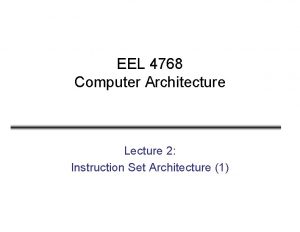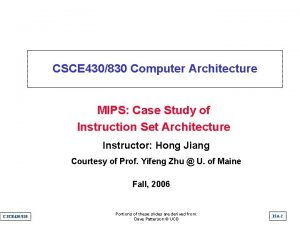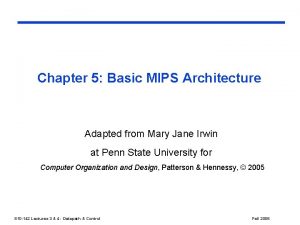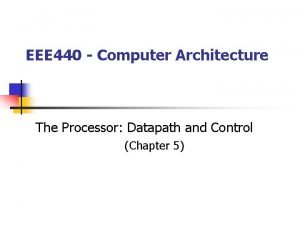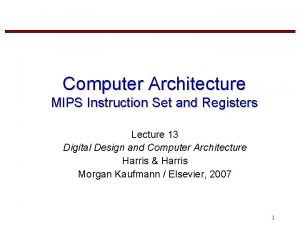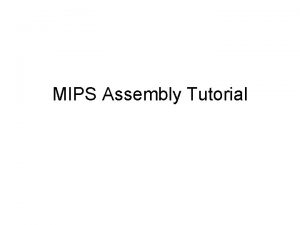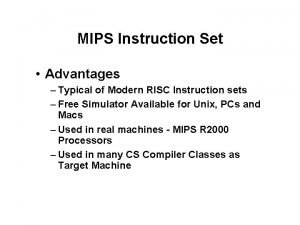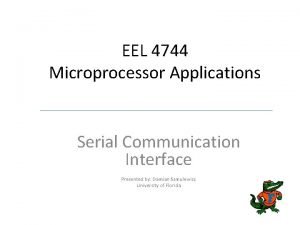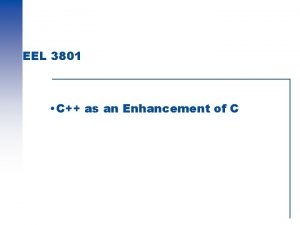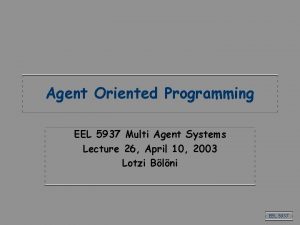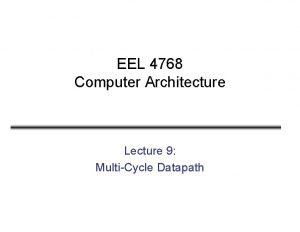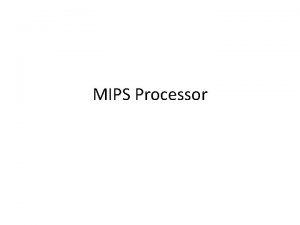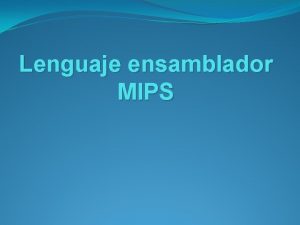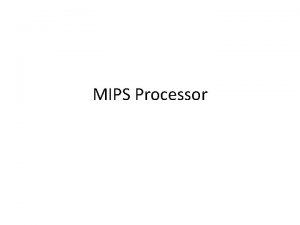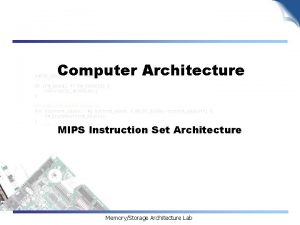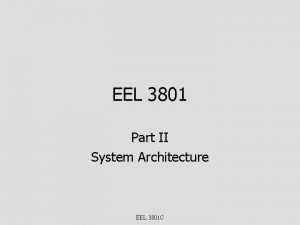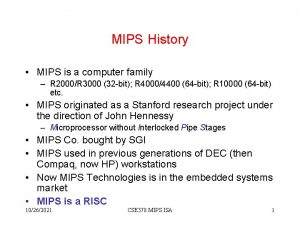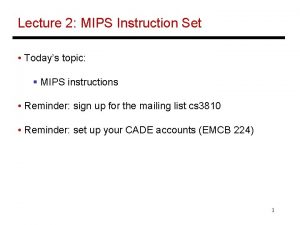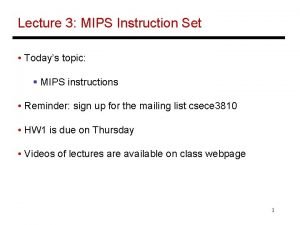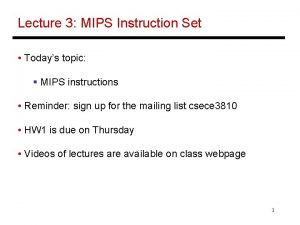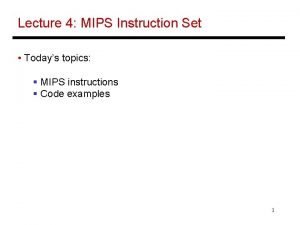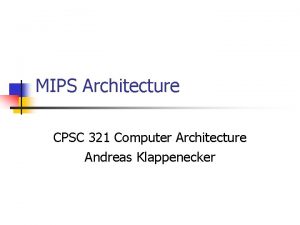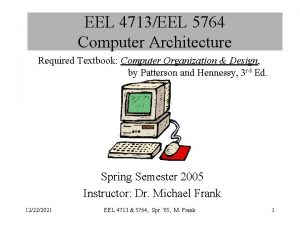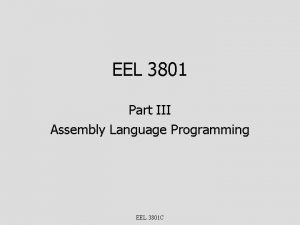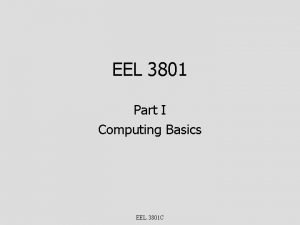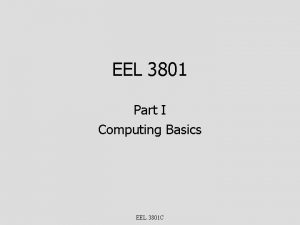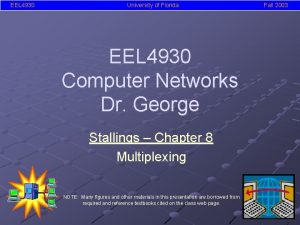EEL 4768 Computer Architecture Lecture 5 MIPS 64








































- Slides: 40

EEL 4768 Computer Architecture Lecture 5: MIPS 64 Examples

Outline • Conversions • Floating-Point Arithmetic • Examples 2

Transfer Between FPRs • • In GPRs, we can use register R 0 to copy one register to another (such as copying R 2 into R 1 via: DADD R 1, R 2, R 0) However, in the FPR, we don’t have the value zero readily available; that’s why the move instructions are provided The move instructions below are used to copy one FPR into another Instruction Syntax Note Move single-precision MOV. S F 0, F 1 F 0 = F 1 Move double-precision MOV. D F 0, F 1 F 0 = F 1 The instruction (. S) or (. D) should correspond to the data type in the FPR 3

Transfers Between FPRs and GPRs • The two instructions below copy the data bit-by-bit; they don’t convert between integer and IEEE 754 format • Conversion instructions are needed to convert Move from coprocessor 1 MFC 1 R 1, F 1 FPR copied into GPR; format is not converted Move to coprocessor 1 MTC 1 R 1, F 1 GPR copied into FPR; format is not converted General-Purpose Registers (GPR) Floating-Point Registers (FPR) 64 -bit R 0 F 0 64 -bit R 1 F 1 64 -bit R 2 F 2 64 -bit … … R 31 F 31 64 -bit 4

Conversions Instruction • There’s no: Syntax Note CVT. D. W F 0, F 1 32 -bit integer (W) to double-precision(D) CVT. D. L F 0, F 1 64 -bit integer (L) to double-precision (D) CVT. D. S F 0, F 1 32 -bit single-precision(S) to double-precision (D) CVT. S. W F 0, F 1 32 -bit integer (W) to single-precision (S) CVT. S. L F 0, F 1 64 -bit integer (L) to single-precision (S) CVT. S. D F 0, F 1 64 -bit double-precision (D) to single-precision (S) CVT. L. S F 0, F 1 Single-precision (S) to 64 -bit integer (L) CVT. L. D F 0, F 1 Double-precision (D) to 64 -bit integer (L) CVT. W. S F 0, F 1 Single-precision (S) to 32 -bit integer (W) CVT. W. D F 0, F 1 Double-precision (D) to 32 -bit integer (W) CVT. L. W or CVT. W. L – L or W, the register they are stored in is already a 64 -bit register 5

Conversions • The convert instruction operates on FPRs only • Even when the data is integer, the CVT takes FPRs only • Therefore, the integer is copied from GPR to FPR and then converted to floating-point CVT. D. L F 0 will contain the equivalent 64 -bit floating-point F 0, F 1 contains an integer 6

Conversion Examples • An integer addition: int a; float f; // in R 1 32 -bit integer // in F 1 32 -bit floating-point a = a + (int)f; // integer addition • The variable ‘f’ should be converted to integer • The conversion should happen in the FPR before moving ‘f’ into a GPR CVT. W. S MFC 1 ADD F 31, F 1 R 30, F 31 R 1, R 30 # convert from single-precision to 32 -bit integer 7

Conversion Examples • • • A floating-point addition: int a; float f; // in R 1 32 -bit integer // in F 1 32 -bit floating-point f = f + (float)a; // floating-point addition The variable ‘a’ should be converted to float The conversion should happen in the FPR; therefore, we should start by moving into the FPR followed by the conversion MTC 1 CVT. S. W ADD. S R 1, F 31, F 31 F 1, F 31 # convert from 32 -bit integer to single-precision 8

Floating-Point Arithmetic Instruction Syntax Add double-precision ADD. D Add single-precision ADD. S Add single pairs ADD. PS Subtract double-precision SUB. D Subtract single-precision SUB. S Subtract single pairs SUB. PS Multiply double-precision MUL. D Multiply single-precision MUL. S Multiply single pairs MUL. PS Divide double-precision DIV. D Divide single-precision DIV. S Divide single pairs DIV. PS Note 9

Assembler Data Directives • The assembler provides the use of data directives to declare variables in the code • The directives below differentiate between the data types: . word 64 -bit integer. word 32 32 -bit integer. word 16 16 -bit integer. byte 8 -bit integer. float. double 32 -bit floating-point 64 -bit floating-point 10

Assembler Data Directives char ch=1; short int sh=2; int n=3; long int x=4; float f=5. 6; double y=7. 8; . . data ch: sh: n: x: f: y: # Data segment. byte 1. word 16 2. word 32 3. word 4. float 5. 6. double 7. 8 . text LA LB LA LH LA LW LA LD LA L. S LA L. D. . . # Text segment R 30, ch # load address of ‘ch’ R 1, 0(R 30) # load ‘ch’ in R 1 using LB R 30, sh R 2, 0(R 30) # load ‘sh’ in R 2 using LH R 30, n R 3, 0(R 30) # load ‘n’ in R 3 using LW R 30, x R 4, 0(R 30) # load ‘x’ in R 4 using LD R 30, f F 0, 0(R 30) # load ‘f’ in F 0 using L. S R 30, y F 1, 0(R 30) # load ‘y’ in F 1 using L. D // 8 -bit int // 16 -bit int // 32 -bit int // 64 -bit int // 32 -bit FP // 64 -bit FP 11

Examples • Write a MIPS 64 code that evaluates this inequality: |a 2 – b| < epsilon • The variables ‘a’, ‘b’ and ‘epsilon’ are of type ‘float’ 12

Examples. data a: b: e: # declaring the data in the program’s memory. float 0. 1. float 0. 01. float 1. 0 e-7 . text LA R 1, a LA R 2, b LA R 3, e L. S F 0, 0(R 1) L. S F 1, 0(R 2) L. S F 2, 0(R 3) MUL. S F 0, F 0 SUB. S F 3, F 0, F 1 ABS. S F 3, F 3 C. LT. S F 3, F 2 BC 1 F not_quite … not_quite # next 3 instructions load the address of # the variables # F 0 <- a # F 1 <- b # F 2 <- epsilon # computes the absolute value (single-precision) 13

Examples • What does this code do? : cvt. w. s F 31, F 0 mfc 1 R 2, F 31 add R 3, R 1, R 2 14

Examples • The code with comments: cvt. w. s F 31, F 0 # convert from single-precision to 32 -bit integer mfc 1 R 2, F 31 # copy the integer to register R 2 add R 3, R 1, R 2 # add R 2 to R 1 • This code converts a floating-point value in an FPR to integer type, copies it into an integer register and adds it to another integer register 15

Examples: Load a 64 -bit Number • Load the 64 -bit number 0 x 11223344 AABBCCDD to R 1 • We can do SLL and ORIs. data n: . word 4 . text. . . LUI R 1, 0 x 1122 ORI R 1, 0 x 3344 DSLL 32 R 1, 32 LUI R 2, 0 x. AABB ORI R 2, 0 x. CCDD DSLL 32 R 2, 32 DSRL 32 R 2, 32 OR R 1, R 2 LA SD R 30, n R 1, 0(R 30) #initial value long int n = 4; . . . n = 0 x 11223344 AABBCCDD; # R 1: 0000 1122 0000 # R 1: 0000 1122 3344 # R 1: 1122 3344 0000 # R 2: 1111 AABB CCDD # R 1: 1122 3344 AABB CCDD # store the value in ‘n’ in the memory 16

Examples: Load a 64 -bit Integer Value • This is another way to do this code • If a constant is used often, we can store it in the memory with the program instead of computing this value with ‘lui’ and ‘ori’ long int n=4; . . . n = 0 x 11223344 AABBCCDD; . data n: const: . word . text. . . LA LD R 30, const R 1, 0(R 30) # contains the 64 -bit value LA SD R 30, n R 1, 0(R 30) # store the 64 -bit constant in ‘n’ at the memory 4 0 x 11223344 AABBCCDD What’s the catch? Why bother with lui and ori? 17

Examples: Loading a Floating-Point Value • Converts a Fahrenheit temperature reading into Celsius: double cel, fah; . . . cel = (fah – 32) *5/9; • The division 5/9 has to be done as a floating-point division • If it were done as an integer division, it yields zero • How can we load the constants 5, 9 and 32 as floating-point values? • We can’t do ADDI with the floating-point • We can either load them as constants with the program (using. double data directive) • Or we can load the ‘ 5’ and ‘ 9’ as integers (with ADDI), then convert them to floating-point using ‘CVT’ 18

Examples: Loading a Floating-Point Value. data cel: . double fah: . double const 5: . double const 9: . double const 32: . double. text LA L. D R 30, fah F 1, 0(R 30) R 30, const 5 F 2, 0(R 30) R 30, const 9 F 3, 0(R 30) R 30, const 32 F 4, 0(R 30) SUB. D F 0, F 1, F 4 MUL. D F 0, F 2 DIV. D F 0, F 3 LA S. D R 30, cel F 0, 0(R 30) . . . 5 9 32 double cel, fah; . . . cel = (fah – 32) *5/9; # 5 stored in IEEE 754 format # 9 stored in IEEE 754 format # 32 stored in IEEE 754 format # F 1 <- fah # F 2 <- 5 # F 3 <- 9 # F 4 <- 32 We’re using a lot of ‘LA’ instructions. We’d better reference the variables with respect to a Global Pointer (as in $gp in MIPS 32) # doing (fah-32) # multiply by 5 # divide by 9 19

Examples: Loading a Floating-Point Value. data cel: fah: . text DADDI MTC 1 CVT. D. L . double cel, fah; . . . cel = (fah – 32) *5/9; . . . R 1, R 0, 5 R 2, R 0, 9 R 3, R 0, 32 R 1, F 1 R 2, F 2 R 3, F 3 F 1, F 1 F 2, F 2 F 3, F 3 LA L. D SUB. D MUL. D DIV. D R 30, fah F 0, 0(R 30) F 0, F 3 F 0, F 1 F 0, F 2 LA S. D R 30, cel F 0, 0(R 30) # constant 5 in floating-point # constant 9 in floating-point # constant 32 in floating-point # doing (fah-32) # multiply by 5 # divide by 9 20

Examples: Loading a Floating-Point Value • Finally, we can rely on the pseudo-instructions to load a floating-point constant • The assembler will store the constant as part of the program (like our previous code) Instruction Syntax Load immediate single-precision LI. S F 0, 2. 3 Load immediate double-precision LI. D F 0, 3. 445 Note 21

Examples: Loading a Floating-Point Value. data cel: fah: . double . text LA L. D R 30, fah F 0, 0(R 30) LI. D F 1, 5 F 2, 9 F 3, 32 SUB. D F 0, F 3 MUL. D F 0, F 1 DIV. D F 0, F 2 LA S. D double cel, fah; . . . cel = (fah – 32) *5/9; . . . # fah loaded in F 0 # pseudo-instruction # subtract 32 # multiply by 5 # divide by 9 R 30, cel F 0, 0(R 30) 22

Examples • Translate the C code below into MIPS 64 assembly long int a, b, c; // 64 -bit integers float average; // 32 -bit float average = (float) (a+b+c)/3; • The code is doing a floating-point division • • a @ 1000 b @ 1008 c @ 1016 average @ 2000 23

Examples. data: a: b: c: avg: . word. float . . . text: LD R 1, 1000(R 0) LD R 2, 1008(R 0) LD R 3, 1016(R 0) DADD R 4, R 1, R 2 DADD R 4, R 3 MTC 1 R 4, F 0 CVT. S. L F 0, F 0 long int a, b, c; @1000 @1008 @1016 @2000 float average; average = (float) (a+b+c)/3; # load a # load b # load c # move the sum to an FPR # convert the sum to a single-precision number LI. S F 1, 3 DIV. S F 2, F 0, F 1 S. S F 2, 2000(R 0) 24

Examples • Translate the C code below into MIPS 64 assembly double a, b, c, average; . . . average = (a+b+c)/3; • • // 64 -bit floats a @ 1000 b @ 1008 c @ 1016 avg @ 2000 25

Examples. data: a: b: c: avg: . double. . . . text: L. D ADD. D F 0, 1000(R 0) F 1, 1008(R 0) F 2, 1016(R 0) F 3, F 0, F 1 F 3, F 2 # load a # load b # load c LI. D F 4, 3 # F 4 <- 3. 0 double a, b, c, average @1000 @1008 @1016 @2000 average = (a+b+c)/3; DIV. D F 3, F 4 S. D F 3, 2000(R 0) 26

Examples • Translate the C code below into MIPS 64 assembly long int A, B, F; … if (A==0 && B==25) F = A + B; // 64 -bit integer • A @ 800 • B @ 808 • F @ 816 27

Examples. data A: B: F: . word . text LD BNE R 1, 800(R 0) R 1, R 0, Exit . . LD R 2, 808(R 0) DADDI R 3, R 0, 25 BNE R 2, R 3, Exit DADD R 4, R 1, R 2 SD R 4, 816(R 0) @800 @808 @816 long int A, B, F; … if (A==0 && B==25) F = A + B; // 64 -bit integer # R 1 <- A # if A!=0, exit # R 2 <- B # R 3 <- 25 # store the result in ‘F’ in the memory Exit: 28

Examples • Translate the C code below into MIPS 64 assembly • It’s the same code as the previous one, except that the variables here are double-precision floating-point double A, B, F; // 64 -bit floating-point … if (A==0 && B==25) F = A + B; • How do we compare to zero? • Zero as floating-point is not readily available; so we have to load it like we will do for 25 • A @ 800 • B @ 808 • F @ 816 29

Examples. data A: B: F: . double. . text LI. D F 0, 0 L. D F 1, 800(R 0) C. EQ. D F 0, F 1 BC 1 F Exit @800 @808 @816 double A, B, F; // 64 -bit floating-point … if (A==0 && B==25) F = A + B; # F 0 <- 0 # F 1 <- A LI. D F 2, 25 L. D F 3, 808(R 0) C. EQ. D F 2, F 3 BC 1 F Exit # F 2 <- 25 # F 3 <- B ADD. D F 4, F 1, F 3 S. D F 4, 816(R 0) # A+B # store the result in ‘F’ in the memory Exit: 30

Examples: For Loop • Translate the C code below into MIPS 64 assembly int i, A; //32 -bit … for (i=0; i<10; i++) A = A + 15; • i @ 800 • A @ 808 31

Examples: For Loop. data i: A: . word 32 . . . @800 @808 int i, A; … for (i=0; i<10; i++) A = A + 15; . text ADDI LW R 1, R 0 R 2, R 0, 10 R 3, 808(R 0) Loop: BEQ ADDI J R 1, R 2, Exit R 3, 15 R 1, 1 Loop Exit: SW SW R 3, 808(R 0) R 1, 800(R 0) # i <- 0 # R 2 <- 10 # R 3 <- A # store A in memory # store i in memory 32

Examples: Looping Over Arrays • Translate the C code below into MIPS 64 assembly long int A[] = {. . . }; long int B[] = {. . . }; long int C, i; . . . for (i=0; i<=100; i++) A[i] = B[i] + C; // array of 64 -bit integers // 64 -bit integers • Use these addresses: C @1000 i @1200 A @2400 B @4800 33

Examples: Looping Over Arrays DADD R 1, R 0 # The variable ‘i’ is set to 0 LD R 2, 1000(R 0) # load C once outside of the loop Loop: DSLL R 3, R 1, 3 # Compute i*8 DADDI R 4, R 3, 2400 # This is the address of A[i] (it’s: 2400+8*i) DADDI R 5, R 3, 4800 # This is the address of B[i] (it’s: 4800+8*i) LD R 6, 0(R 5) # load B[i] DADD R 6, R 2 # B[i] + C SD R 6, 0(R 4) # store the result in A[i] DADDI R 1, 1 # increment i DADDI R 7, R 1, -101 # has the counter reached 101? BNEZ R 7, loop # if not 101 then repeat SD R 1, 1200(R 0) # store the counter ‘i’ in the memory 34

Examples: Find Max • Translate this code that finds the maximum float value in the array double arr[40] = {2. 3, 4. 3, . . . }; // 64 -bit floating-point double max; // 64 -bit floating-point i; // 32 -bit integer max = arr[0]; for(i=0; i<40; i++) { if(arr[i] > max) max = arr[i]; } • These are the addresses: i @1000 max @1008 arr @2000 35

Examples: Find Max DADDI L. D Loop: BEQ L. D C. GT. D BC 1 F MOV. D Skip: DADDI J R 1, R 0, 2000 R 2, R 1, 320 # point at the array # end of array (40 elements x 8 bytes) F 0, 0(R 1) # F 0 is max; initialized to first array location R 1, R 2, Exit F 1, 0(R 1) F 1, F 0 Skip F 0, F 1 # F 1 <- array data # is new data larger than max; F 1 > F 0 ? # if not, don’t change anything # if yes, F 0 is set to F 1 R 1, 8 Loop S. D F 0, 1008(R 0) # max is set to the maximum value found ADDI SW R 3, R 0, 40 R 3, 1000(R 0) # when the code finishes, i=40 36

Examples • Translate the program into MIPS 64 assembly code float A 1, A 2; float B 1, B 2; float C 1, C 2; . . . C 1 = A 1+B 1; C 2 = A 2+B 2; // 32 -bit floating-point • This is the memory layout Memory 80: A 1 84: A 2 … 160: B 1 164: B 2 … 800: C 1 804: C 2 Single-precision (32 -bit) 37

Examples L. S F 0, 80(R 0) F 1, 84(R 0) F 2, 160(R 0) F 3, 164(R 0) # F 0 <- A 1 # F 1 <- A 2 # F 2 <- B 1 # F 3 <- B 2 ADD. S F 4, F 0, F 2 ADD. S F 5, F 1, F 3 # F 4 <- A 1 + B 1 # F 5 <- A 2 + B 2 S. S # C 1 <- (A 1+B 1) # C 2 <- (A 2+B 2) F 4, 800(R 0) F 5, 804(R 0) 38

Examples: Single Pairs • This is another way to do the code using the ‘single pairs’ L. D F 1, 80(R 0) F 2, 160(R 0) ADD. PS S. D • # F 0 <- (A 1, A 2) # F 2 <- (B 1, B 2) F 0, F 1, F 2 F 0, 800(R 0) The advantage of using ‘single pairs’ is reducing the number of instructions fetched from the memory (4 vs 8 in previous slide) F 0 (A 1+B 1) (A 2+B 2) F 1 A 2 F 2 B 1 B 2 Usingle pairs, load A 1 and A 2 in F 1; and load B 1 and B 2 in F 2; do one single pairs addition 39

Readings • H&P CA – App K 40
 Eel 4768
Eel 4768 Eel 4768
Eel 4768 Mips instruction format
Mips instruction format Mips architecture
Mips architecture Basic mips implementation in computer architecture
Basic mips implementation in computer architecture Computer architecture notes
Computer architecture notes Computer architecture lecture
Computer architecture lecture 01:640:244 lecture notes - lecture 15: plat, idah, farad
01:640:244 lecture notes - lecture 15: plat, idah, farad Bus architecture in computer organization
Bus architecture in computer organization Computer architecture and organisation
Computer architecture and organisation What is basic computer organization
What is basic computer organization Mips instruction set architecture
Mips instruction set architecture Mips architecture tutorial
Mips architecture tutorial Advantages of mips architecture
Advantages of mips architecture Arthur kipps quotes
Arthur kipps quotes Pelican gulper eel
Pelican gulper eel Deep-sea shrimp
Deep-sea shrimp Eel 3801 lab manual
Eel 3801 lab manual Eel gird
Eel gird Rahvusvahelised suhted
Rahvusvahelised suhted Eel 3705
Eel 3705 Estagio eel usp
Estagio eel usp Deep sea hatchetfish adaptations
Deep sea hatchetfish adaptations Producers
Producers C++ eel
C++ eel Metaphor
Metaphor Simile challenge
Simile challenge Ncprepswimming
Ncprepswimming Simile a
Simile a Sentence variety
Sentence variety Escola de engenharia de lorena
Escola de engenharia de lorena Eel 4712
Eel 4712 Eel programming language
Eel programming language Computer security 161 cryptocurrency lecture
Computer security 161 cryptocurrency lecture Computer aided drug design lecture notes
Computer aided drug design lecture notes What is architecture business cycle?
What is architecture business cycle? Call and return architecture
Call and return architecture Modular vs integral product architecture
Modular vs integral product architecture Product architectures
Product architectures Computer organization and architecture 10th solution
Computer organization and architecture 10th solution Computer architecture 101
Computer architecture 101

